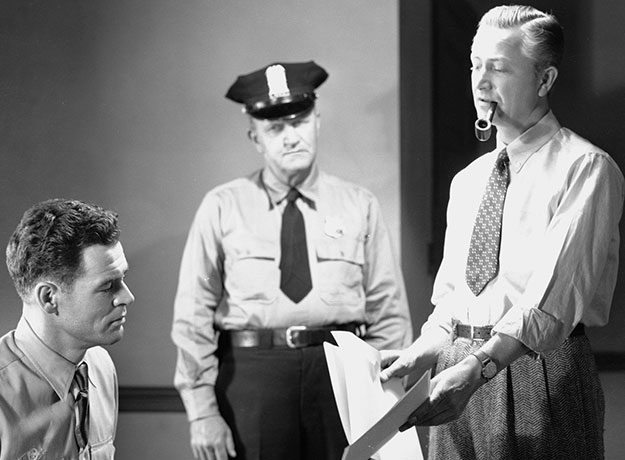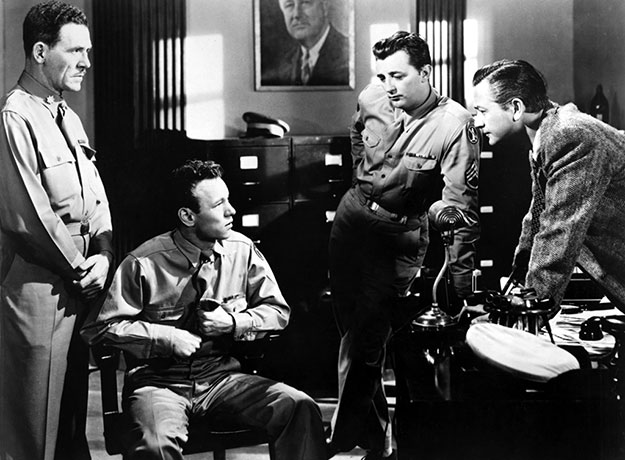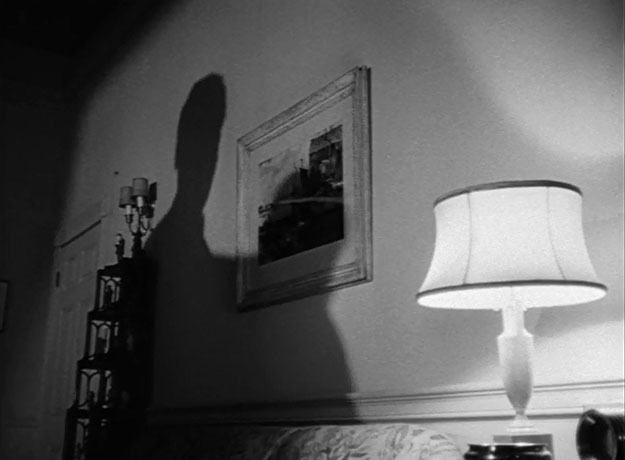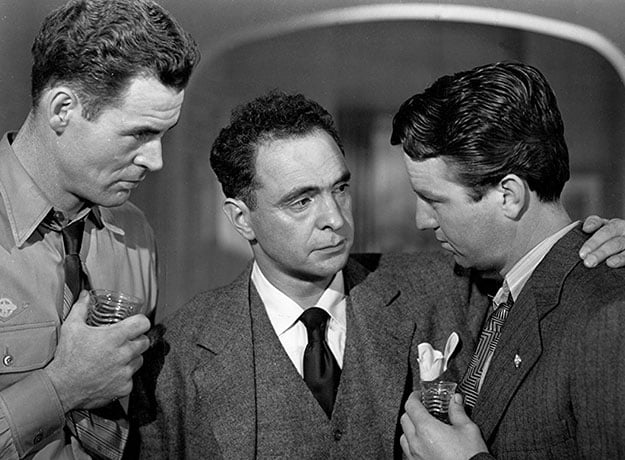The history of queerness on film is largely a history of exclusion. Gay characters on screen are a relatively recent phenomenon, which leaves about 80 percent of our film heritage a vacuum of representation. Because of this, it’s important to wrestle with those films for which queerness wasn’t even a remote consideration as well as those for which bigotry and self-censorship made it actively impossible to portray. Case in point: Edward Dmytryk’s noirish 1947 murder mystery Crossfire retrospectively functions on two levels at once, as the powerful film that it is and the phantom film that it never could be, the one that exists alongside it only in our imaginations. Crossfire has various claims to fame. It was a breakthrough for many of its actors, including Gloria Grahame and two intimidating Roberts, Mitchum and Ryan; it’s a potent, freshly post–World War II drama that doesn’t shy away from the lingering psychological scars on those who fought in the war; and, for many, it’s that other 1947 film about anti-Semitism, the angry stepsibling to Elia Kazan’s gentler Gentleman’s Agreement, the Best Picture Oscar winner that starred Gregory Peck as a journalist experiencing bigotry firsthand after going undercover as a Jew. Where Gentleman’s Agreement lectures, Crossfire pummels. The whole thing hinges upon the investigation surrounding the murder of a Washington, D.C. man named Samuels, beaten to death in his own apartment. Police Captain Finlay (Robert Young) believes the killer to have been one of a group of recently discharged GIs who had been carousing at Samuels’s place, none of them with an evident personal connection to the victim, thus with no apparent motive. At the opening of the film, we see the deadly melee only in silent silhouette: punches are thrown, a lamp is knocked over, a body is left immobile on the floor. As the inquiry unfolds, we learn there was a trio of men in Samuels’s apartment: nervous, naïve Floyd Bowers (Steve Brodie); baby-faced Corporal “Mitch” Mitchell (George Cooper), who left his wallet in the sofa after suspiciously fleeing the scene; and the glowering Montgomery (Ryan), who, even more suspiciously, seems all too willing to assist the police in their search. Mitchum’s Sergeant Keeley, Mitch’s loyal best friend, more hesitantly helps Finlay propel the investigation forward, the actor’s innate passive quality making the character a mysterious assistant rather than the reliable straight-shooter he may have been on the page.
The more we learn about sweet-natured, PTSD-afflicted Mitch, the less plausible he seems as a suspect: after drunkenly running out of the apartment to avoid fisticuffs when things get heated between the men, he ends up hiding out at the home of steely but soft-hearted dancehall girl Ginny (Grahame), a tricky alibi for the married man to admit. Getting to know Montgomery, on the other hand, only enhances our misgivings about him: racist, belligerent, though often wearing a broad, false smile, he is an insidious, irredeemable creation, so persuasively played by the six-foot-four Ryan that the actor—a progressive liberal and occasional social activist for civil liberties—came to resent the role, blaming it for getting him typecast as villains throughout his career. We eventually realize that Montgomery killed Samuels for no other reason than that he was a “Jew-boy,” a hate crime pure and simple. Hate is the central word, theme, and abstract idea of Crossfire. An attempt to confront an America irrevocably altered, Dmytryk’s film gives its audience a bitter pill to swallow: that hate is so deeply embedded in the national psyche it might be the only thing uniting people postwar. A crucial scene set in the bar where the men first meet Samuels (Sam Levene) expresses most of the film’s underpinning philosophical despair. Samuels, who had served in Okinawa before being put on medical disability, opines that there’s no real readjustment, no common mission or goal now that they’ve returned from the war: “We just don’t know what to fight. You can feel the tension in the air. A whole lot of fighting and hate that doesn’t know where to go . . . Maybe we’ll stop hating and start liking things again.” His words particularly appeal to Mitch, and the two hit it off, so Samuels invites Mitch up to his place for another drink. Montgomery invites himself along—and brings Floyd—for a more nefarious reason. As he later describes Samuels to Finlay, all but incriminating himself: “I’ve seen a lot of guys like him . . . Some of them are named Samuels. Some of them got funnier names.” Later, he’s even more direct to Floyd: “I don’t like Jews and I don’t like nobody who likes Jews.” With its flashback structure, intense low-key lighting, and the rich psychological portraiture of even the smallest characters, Crossfire has the look and depth of a signature ’40s noir, but it’s really a social problem picture in drag—like a Stanley Kramer picture with style or one of those instructively anti-fascist genre films of the era such as Brute Force. Because the movie is so direct in its messaging and pleasingly two-fisted in its delivery, it’s easy to sometimes overlook the central oddness of the narrative’s inciting event. If it seems like there’s something unspoken in the circumstances around the murder—i.e., why would an unassuming man invite strange men he just met at a bar up to his apartment in the first place?—that’s because there is. Crossfire was a loose adaptation of the 1945 novel The Brick Foxhole, written by future filmmaker Richard Brooks (In Cold Blood) when he was still in the Marines. In the book, the Samuels character, named Edwards, is targeted and murdered not because he’s Jewish but because he’s a homosexual, or, in the parlance of the novel, “a fairy,” mocked by Montgomery for being “a simply wonderful interior decorator.” The soldiers meet him while hitchhiking into the city, and en route to his apartment, an almost gleeful Floyd whispers to Montgomery, “We’re set, buddy. Set. I ain’t beaten up a queer in I don’t know how long.” The nature of the killing as set out in the novel is therefore a lure, a textbook method for seducing and victimizing gay men, and which doesn’t as easily track when transposed to a circumstance of Jew-baiting.
Though RKO’s new head, Dore Schary, and social-minded producer Adrian Scott long planned to adapt the book, it was clear early on that the motivations for the hate crime would have to be altered. Scott (who had worked with Dmytryk on 1944’s Murder My Sweet and 1945’s Cornered) optioned The Brick Foxhole for the screen, but in a letter to RKO, the Production Code Administrator’s moralizing moron Joseph I. Breen wrote, “The story is thoroughly and completely unacceptable, on a dozen or more counts. It goes without saying that any motion picture following, even remotely, along the lines in the novel, could not be approved.” However, homosexuality was such an unthinkable—and unwanted—subject that even the producers of Crossfire, who were some of Hollywood’s most altruistic, left-wing filmmakers, didn’t need the PCA to restrict it for them. Scott had already intended to change the novel so that it more centrally tackled anti-Semitism than homophobia, hoping to make a progressive film that spoke to the rising tide of intolerance and conservatism in America following the war. Schary fast-tracked the film so it would come out before rival Daryl Zanuck’s Gentleman’s Agreement, which was filming concurrently. But such healthy competition didn’t make the project any less anxiety-producing for RKO, as many felt even this topic was too taboo. That making an anti-anti-Semitism picture proved to be controversial within an industry almost uniformly run by Jewish men speaks to Hollywood’s assimilationist timidity and therefore the utter impossibility of a faithful adaptation of the multifaceted The Brick Foxhole. Crossfire’s awkward narrative retrofitting—the sense that something is missing—feels pronounced if one knows the preproduction history of the film, yet traces of queerness linger around the edges, intentionally or not. With his soft, dark eyes and sensitive demeanor, George Cooper (a contract actor for RKO who had served in the Navy during WWII, appearing in his first movie) makes Mitch a plausible object of desire for Samuels, and the two men share many intimate moments that have the feel of seduction, the kind of charged, almost sensual understanding forged by men in isolated circumstances. The sensitive Mitch’s extended, ultimately impotent interaction with Grahame’s floozy also feels lightly coded, especially when placed alongside the physical estrangement he feels from his wife (Jacqueline White) as well. And the film ends on a tender touch from Mitchum: “How about a cup of coffee, soldier?” Keeley asks Leroy, a younger soldier who had helped entrap Montgomery, as he gently places his hand between the younger man’s shoulder blades as they walk off together, a subtle homoeroticism that can’t help but recall what’s been erased. Most importantly, one of the book’s main themes could never be eradicated: the homosocial bonds created by war and the resulting crisis of masculinity felt by the returning soldiers. Expectations that “our boys” would readjust to the heterosexual American way of life upon coming home put undue pressure on them to conform. At the same time there was an increasingly present panic over gay men in the military, shining new light on homosexuality across the board with the result that homosexual teachers and government officials were being targeted and fired from their jobs in the postwar ’40s and ’50s. Homophobia was thus on the rise as an acceptable form of intolerance—a state of affairs that would endure, even in liberal circles, for decades to come. The decision to leave it out of Crossfire inherently creates a hierarchy of bigotry, running counter to the abiding ideas of Richard Brooks’s book, which places the vile Montgomery’s homophobia along a wide spectrum of indiscriminate hate. A raging nationalist, he hates “rotten refugees” and all foreigners, and—in an underlining that such fascists often held positions of power—had served on the Chicago police force. Wrote Brooks, “His peccadilloes had been the shooting of two Negro suspects and one petty Jewish thief.” Even more frightening than Brooks’s use of the word “peccadilloes” is the detail that Montgomery liked to shoot his victims in the belly so they wouldn’t die right away, and that he liked to watch their bodies “squirm” as they expired.
Thanks to Finlay’s climactic speech, the film gestures at the idea that all intolerance is the same (“Hate is like a gun you carry with you that can go off at any time”), but Hollywood films, always refracting, never radical, have only ever been as brave as the surrounding culture will permit. For Scott, Dmytryk, Schary, and much of the political left of the period, devoted to civil and labor rights, homophobia may have existed, but it was not a political issue. Though one could say they played it relatively safe on Crossfire, the filmmakers were nevertheless marking themselves as potential subversives in the eyes of the anti-Communist American right-wing that was gaining strength. Later that very year, the House Committee on Un-American Activities called Dmytryk and Scott to Congress, where they were uncooperative, “unfriendly” witnesses placed on the Hollywood Ten, and blacklisted for the next decade. Perhaps out of a newfound solidarity, Scott would write, in an editor’s letter to the New York Herald Tribune in the mid-fifties, that to fire men and women from their jobs for suspected homosexuality “is an uncivilized practice, one which does not advance us prominently as an understanding people.” Of course, an important caveat: “I am not now, nor have I ever been a homosexual, nor do I intend to be.” Michael Koresky is the Director of Editorial and Creative Strategy at Film Society of Lincoln Center; the co-founder and co-editor of Reverse Shot; a frequent contributor to the Criterion Collection; and the author of the book Terence Davies, published by University of Illinois Press.



